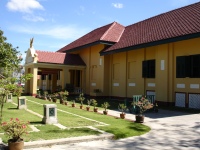Thanks to the quite special selection of antiquarian books at
Tamarind Books and a business trip to the US which helped me save a lot of shipping cost, I have added a few new books to my library about or closely related to the topic of this blog.
The first one -
Provincial administration and local government in Thailand by William A. Sommers - I had already
discovered some time ago, but except the fact that one copy was available I wasn't able to find any details about it. It turns out to be just a pamphlet of 13 pages (plus one chart), published in 1969 by the Department of Local Administration. Sommers worked as USOM advisor to the Thai Ministry of Interior in the late 1960s.
Similar, but with 30 pages about the double size, is the pamphlet
Local Government in Thailand by Daniel Wit. It was published by the Ministry of Interior in 1958, and according to the preface is an extract of the book "Comparative Local Government and Administration" published by the Thammasat University.
Also only a pamphlet is the
Thailand Population Census 1960 Changwad Series: Changwad Chiengmai, which I bought just out of curiosity. I would have preferred to catch the Surat Thani issue, but since it is basically nothing but the census numbers, which for the 2000 census were available for free as Excel sheets. I hope the
National Statistical Office will publish the full data from the older census when this year's census is complete, but I am sure it's just in vain.
Wilfred D. Reeve's
Public administration in Siam, originally published in 1951, also just has 93 pages and gives an overview over the whole public administration, thus the territorial and local administration is only a small part of this book. But what is striking is that the two most pressing problems of the administration in 1951 were the corruption and nepotism in nomination of government officials. While the corruption is not as open as it was back then, the last 60 years hasn't changed that much in Thailand it seems.
Politics in Thailand by David A. Wilson is more about the government politics, parliament, political parties. Published in 1962 it is also covering the same time-period as the other books, but as it focuses on the higher political levels it seems to be the one least related to this blog.

And finally from a different antiquarian, the book
Thailand: The Modernization Of A Bureaucratic Polity by Fred W. Riggs, published in 1967, is also a very interesting read. Especially chapter seven which covers the territorial administration gives quite a lot of details of these entities in the past, it is the first place where I found anything about the
regions which were created as a supplement of the Monthon.
Thus a lot of new material to work through, and I am sure I can make several postings with interesting quotes from these books. It is just sad that the copyright laws won't allow me to digitize all the pamphlets and make them available for the public, even though I doubt anybody could use the rights commercially. These works are probably only of interest for a few academics and one crazy amateur researcher...
 After nearly 3 months of downtime, the website amphoe.com has suddenly come back to life. When I last checked for it mid-December the nameserver was still not responding and thus the site inaccessible, but now yesterday it worked again. Thus apparently the administrator of the nameserver managed to switch it on again, and the website reappeared as nothing ever happened.
After nearly 3 months of downtime, the website amphoe.com has suddenly come back to life. When I last checked for it mid-December the nameserver was still not responding and thus the site inaccessible, but now yesterday it worked again. Thus apparently the administrator of the nameserver managed to switch it on again, and the website reappeared as nothing ever happened.
















